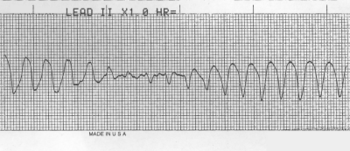Torsades de pointes: Difference between revisions
Jump to navigation
Jump to search

imported>Robert Badgett No edit summary |
imported>Robert Badgett No edit summary |
||
| Line 1: | Line 1: | ||
{{subpages}} | {{subpages}} | ||
[[Image:Torsades de Pointes.png|right|thumb|350px|{{#ifexist:Template:Torsades de Pointes.png/credit|{{Torsades de Pointes.png/credit}}<br/>|}}Torsades de Pointes in [[electrocardiogram]] limb lead II.]] | |||
In cardiology, '''Torsades de Pointes''' is a "malignant form of polymorphic [[ventricular tachycardia]] that is characterized by heart rate between 200 and 250 beats per minute, and QRS complexes with changing amplitude and twisting of the points. The term also describes the syndrome of tachycardia with prolonged ventricular repolarization, long QT intervals exceeding 500 milliseconds or bradycardia. Torsades de pointes may be self-limited or may progress to [[ventricular fibrillation]]."<ref>{{MeSH}}</ref> | In cardiology, '''Torsades de Pointes''' is a "malignant form of polymorphic [[ventricular tachycardia]] that is characterized by heart rate between 200 and 250 beats per minute, and QRS complexes with changing amplitude and twisting of the points. The term also describes the syndrome of tachycardia with prolonged ventricular repolarization, long QT intervals exceeding 500 milliseconds or bradycardia. Torsades de pointes may be self-limited or may progress to [[ventricular fibrillation]]."<ref>{{MeSH}}</ref> | ||
Revision as of 16:17, 19 July 2008
In cardiology, Torsades de Pointes is a "malignant form of polymorphic ventricular tachycardia that is characterized by heart rate between 200 and 250 beats per minute, and QRS complexes with changing amplitude and twisting of the points. The term also describes the syndrome of tachycardia with prolonged ventricular repolarization, long QT intervals exceeding 500 milliseconds or bradycardia. Torsades de pointes may be self-limited or may progress to ventricular fibrillation."[1]
Causes/etiology
Torsades may be caused by drugs that prolong the QT interval.[2] A list of these drugs is available at the Arizona Center for Education & Research on Therapeutics.
Treatment
The treatment is intravenous magnesium.
References
- ↑ Anonymous (2024), Torsades de pointes (English). Medical Subject Headings. U.S. National Library of Medicine.
- ↑ Roden DM (March 2004). "Drug-induced prolongation of the QT interval". N. Engl. J. Med. 350 (10): 1013–22. DOI:10.1056/NEJMra032426. PMID 14999113. Research Blogging.
External links
- http://torsades.org - Arizona Center for Education & Research on Therapeutics
